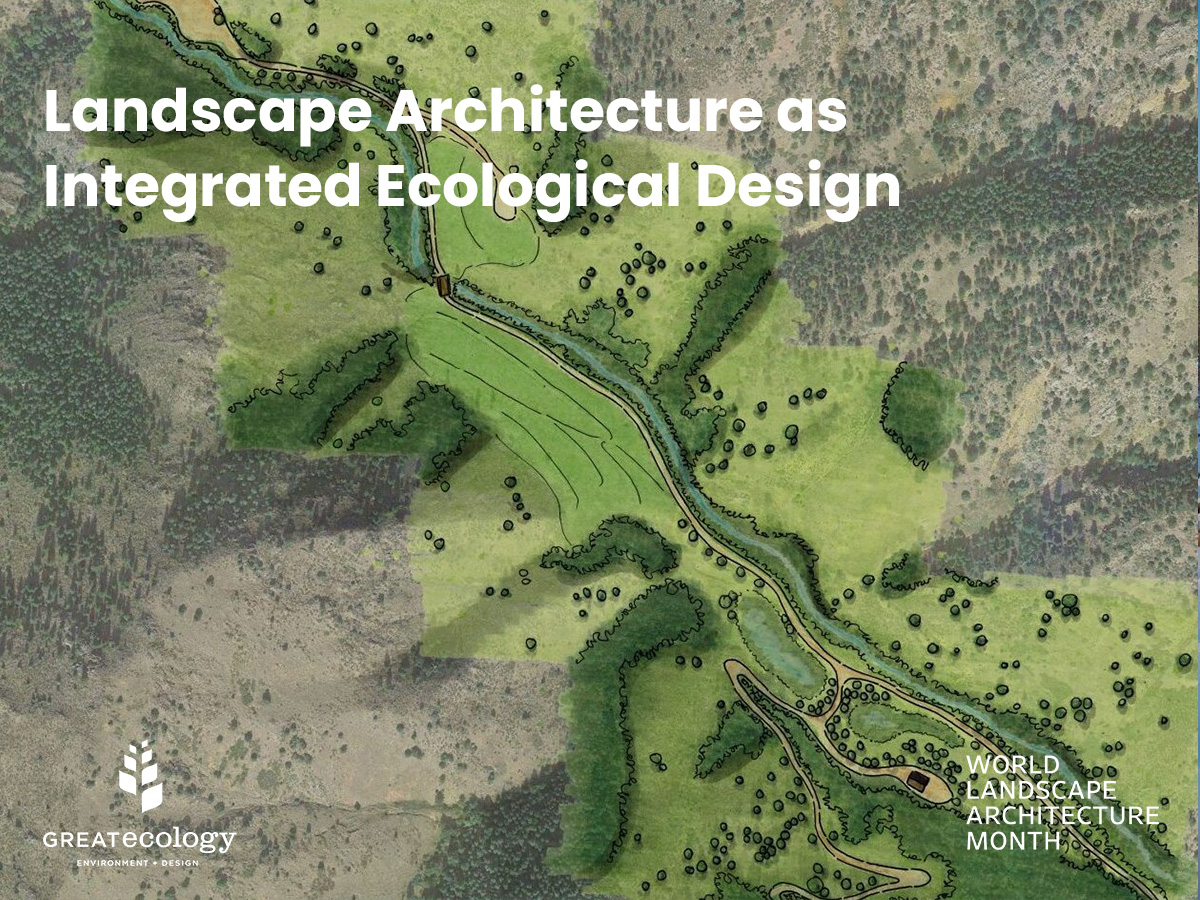
Biodiversity through Ecological Design at Great Ecology
April 22, 2024
Resilient Landscapes at Great Ecology
April 24, 2024
Biodiversity through Ecological Design at Great Ecology
April 22, 2024
Resilient Landscapes at Great Ecology
April 24, 2024Blog & News

April 23, 2024
Landscape Architecture as Integrated Ecological Design
Author: Hilary Mulford
April’s designation as World Landscape Architecture Month by the American Society of Landscape Architects (ASLA) is the perfect opportunity to recognize the important work of our landscape architecture & planning department here at Great Ecology along with the work of other professionals around the world.
What is Landscape Architecture?
ASLA describes landscape architecture as the process of “creating healthy, safe, and beautiful outdoor places for everyone,” by “bringing science and design together to make our communities better places to live, work, and play.”
Individuals pursuing a career in landscape architecture are required to complete rigorous collegiate degree programs as well as pass four sections of the Landscape Architecture Registration Examination, and often a supplemental state examination. Like doctors and engineers, landscape architects are licensed to support public safety and security.
Becoming a professional in this field is a highly interdisciplinary endeavor. Landscape architectural training leads trainees to be able to effectively communicate with other allied professionals. In any given project, we utilize input from civil and environmental engineers, geologists, hydrologists, horticulturalists, ecologists, wildlife biologists, wetland scientists, planners, developers, and community members. All perspectives need to be considered and implemented into the final design. In this way, landscape architects often serve as lead authors and visionaries for site design and implementation.
What Role Do Landscape Architects Have in Interdisciplinary Work?
These cross-disciplinary communication skills make landscape architecture professionals well suited for project management roles and key players in related fields. We often lead phases of a project from master planning and feasibility studies to schematic design and construction documents, all the way through permitting, construction administration, and maintenance coordination.

As often as we lead, we also serve as contributors on large-scale civil engineering, architecture, and planning projects. For example, we may be brought on by an architecture firm to design green infrastructure for a new workforce housing development, by a civil engineering group to formulate a native planting plan for wildlife corridors over a new roadway, or by city planners to provide plans for pedestrian and bike-friendly avenues.
How Does Great Ecology Approach Landscape Architecture?
At Great Ecology, our landscape architecture team employs an integrated ecological design process. We encourage an iterative design process that results in thoughtful, scientifically-driven, purposeful solutions. By combining sustainable design with ecological principles, we create green spaces, habitats, and master plans that transform the environment. We take a holistic design approach that considers site-specific habitats, climate change, and community needs. Our design and ecology teams regularly participate in charrettes and workshops where our teams discuss, articulate, and refine science-backed design solutions. These integrated sessions are one way in which we embed sound ecological principles into our landscape design solutions.

A hand sketched site analysis plan depicting ecotypes, slope, and vegetation cover.
After thorough site analysis and team coordination, we create high-functioning, low-maintenance spaces that blend into the surrounding environment and benefit the local community. This includes prioritizing native plant palettes and seed mixes, improving community access to nature, developing sustainable recreation, and implementing green infrastructure. Our green infrastructure projects incorporate both the natural environment and engineered products to conserve ecosystem services and functions, control erosion, reduce nutrient loading on local waterways, restore sinuosity to streams and rivers while reconnecting them to their floodplains, and improve habitat.
What Methods of Communication Do Landscape Architects Use?
We are skilled in the process of combining art and science to draw up landscape systems that are able to thrive in all kinds of environments. We do this by distilling complex scientific and social processes into tangible graphics and deliverables. To communicate our ideas with clients, communities, and coworkers, we choose a variety of tools throughout the design process, from iterative sketches on trace paper to polished photorealistic renderings.

A sketched rendering of pathways, tree-cover, and picnic areas over a CAD-drafted site plan.
Some of our other artistic media of choice include: pens and sketchbooks, AutoCAD and Photoshop, plants and soil, boulders and water, trees and paths, and everything in between. Our artistry is informed by ecology, biology, horticulture, sociology, and psychology. At Great Ecology, we are lucky to work side-by-side with ecology and biology staff to integrate their research and knowledge into our designs.
Integrated Ecological Design Projects
Great Ecology has successfully employed integrated ecological design in hundreds of projects over the years. Some of the most notable include:

Conceptual restoration plans for sensitive salt marsh habitat along the Hudson River on Randall’s Island in New York.

A conceptual ecological restoration strategy for over 500 acres of land in Golden, CO surrounding the former Schwartzwalder Mine, once the largest uranium mine in the United States.

The design of La Lomita Park in Southwest Denver focused on creating an ecological space residents feel connected to, while updating existing playground features and implementing a nature-based stormwater system.

Strategic design and technical expertise in planning Brooklyn Bridge Park which included the conversion of the East River industrial piers into recreational areas, providing public access to restored native coastal and intertidal coastal habitats.

